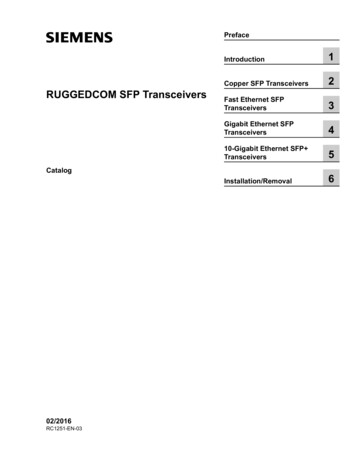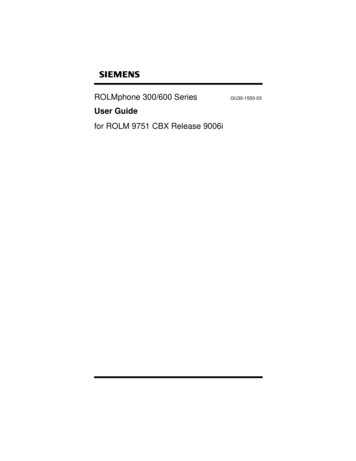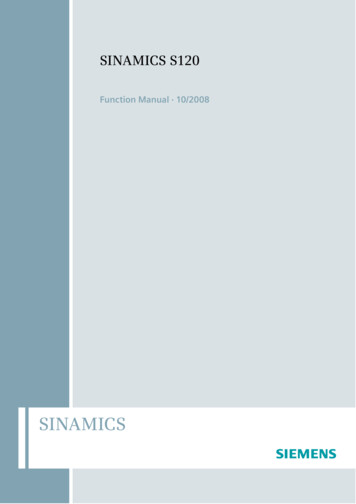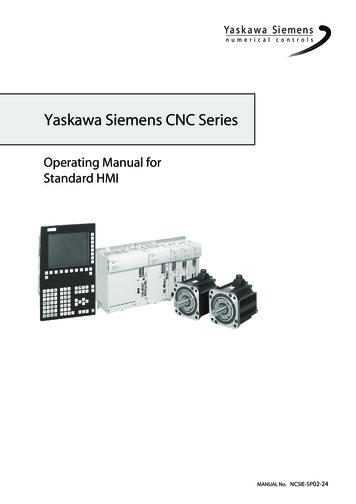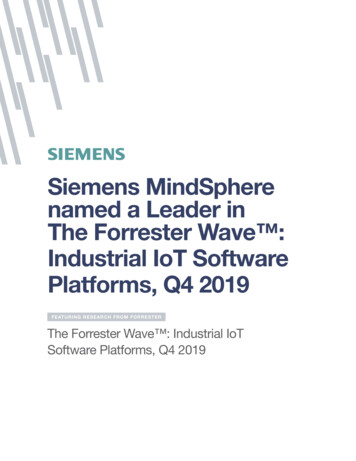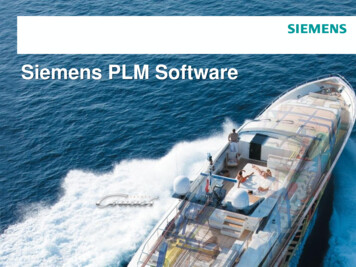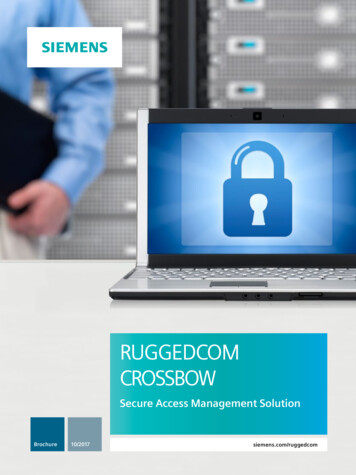
Transcription
RUGGEDCOMCROSSBOWSecure Access Management SolutionBrochure10/2017siemens.com/ruggedcom
RUGGEDCOM CROSSBOW ContentsRUGGEDCOM CROSSBOW is a proven Secure AccessManagement solution designed to provide cybersecurity compliance including NERC CIP access toIntelligent Electronic Devices.ContentsProduct overview 3Application overview 4System overview 6Secure Access Managerand Station Access Controller 8Server and client requirements 10Component options 112
Product overview RUGGEDCOM CROSSBOWProduct overviewRUGGEDCOM CROSSBOW is a scalable solution tailored to the ever increasing industrial and utilityasset owners needs. It provides secure, local and remote user access, as well as management ofIntelligent Electronic Devices and their associated files. It is an enterprise class solution incompliance with comprehensive cyber security standards including the ever evolving US NERC CIP.RUGGEDCOM CROSSBOW is a unique cyber security systemdesigned to be simple, economical and intuitive enoughto be operated by large numbers of personnel accordingto, and without inhibiting their normal duties. Users ofthe system could be from a diverse group of staffassociated with: Asset condition monitoring Event response and investigation Maintenance (including vendors) Control, protection and telecommunicationsengineeringUser access is governed by the appropriate authenticationmodel (e.g. Active Directory, RSA SecurID) and alluser activity is logged and reported per the NERC CIPspecification. When used in combination with theRUGGEDCOM CROSSBOW Station Access Controller forlocal substation access, the RUGGEDCOM CROSSBOWsystem provides an integrated, comprehensive solutionwith a seamless configuration environment, ensuring IEDconnectivity and activity logging is maintained at thesubstation level, even if the connection to the centralserver is disabled.CROSSBOW allows an Intelligent Electronic Device (IED)maintenance application to remotely communicate withits associated IEDs as if the users were directly connectedto the device. CROSSBOW’s client-server architecture isdesigned to allow a large utility to easily manage remoteconnectivity to its entire population of field IEDs. Useraccess is role based, and the user is not provided withany device password or network topology detail.In addition, CROSSBOW allows extensive automation ofcommon device management tasks, such as passwordchanges, file retrieval, and configuration management.CROSSBOW functionality may be extended through scriptsand plug-ins, allowing users to develop automatedsolutions to their unique requirements.CROSSBOW also provides a mechanism to discoverpreviously unknown or transient devices connected tothe IP network, providing an additional tool to enhancenetwork security and maintainability.3
RUGGEDCOM CROSSBOW Application overviewApplication overview4
Application overview RUGGEDCOM CROSSBOWClient server architectureThe CROSSBOW client-server architecture is designed toscale to the needs of small, medium and large utilitieswhile maintaining peak performance to its entirepopulation of field IEDs. Key features include: Vendor agnostic design that works with all commonsubstation gateways and IEDs, allowing deploymentwithout adding or upgrading substation devices; An intuitive, complete product solution for ease of useand configuration:–– Competitive solutions rely more heavily onintegrating multiple 3rd party technologies together,making deployment and maintenance morecomplicated; A scalable, extendable platform, including:–– Password management of relaysand gateway devices;–– Firmware management of relaysand gateway devices;–– Device configuration management (e.g. relay settings);–– Event file (e.g. fault/oscillography) retrieval, eitheron demand or automatically scheduled. Integrated file management facility allows utilitystaff to control and retrieve device related files:–– Includes version control, check-in/check-out,access control, and reporting;–– Includes management of files associated withelectromechanical and non-communicatingdevices, which may otherwise have no meansof file management.A unique solution for local or emergency substation access,the CROSSBOW Station Access Controller provides the samelevel of security at the substation by pushing CROSSBOWdatabase updates out to the field. This unique offering runsnatively on the RUGGEDCOM Multi-Service Platforms basedon ROX (Rugged Operating System), so no additionalsubstation computers are required.Benefits Meets NERC standards for cyber security Strong (2-factor) authentication Individual user accounts and privileges Audit log of activity WAN or dial-up access to remote devicesSecurity Integration with Active Directory, RSA SecurID andother enterprise authentication solutions Individual user accounts with highlyconfigurable permissions Audit log/reports of all activity Ability to block commands on a per devicetype/per user basis Role based user access control Local substation access control throughStation Access Controller Blocking and logging of specified IED commands Optional encryption between server and remote facilityEnterprise integration Reporting interface into event management systems(Industrial Defender, TDi, OSIsoft) Microsoft SQL server-basedNERC CIP complianceAs the first commercially available application for helpingcustomers with achieving NERC CIP compliance,RUGGEDCOM CROSSBOW has maintained a leadership rolein the field. When combined with RUGGEDCOM routersand multi-service platforms, CROSSBOW offers one of theonly completely integrated solutions for the substation: One-click compliance reports Following the CIP requirements setout for access control and change management User activity (key stroke) loggingEase of administration Administration interface allows managementof thousands of IEDs and hundreds of users Structured view of IEDs (region/substation/gateway) Grouping of devices and users Configurable sub-adminsFlexible architecture Client-server or “clientless” architecture usingvirtual desktops Available redundancy Dial-up or WAN accessBroad device supportPreserves investment in legacy gateway devicesand communication infrastructure Siemens RUGGEDCOM routers and switches Siemens SIPROTEC Garrettcom SEL GE ABB Novatech Cooper RFL Industrial Defender Micom Many other IEDs5
RUGGEDCOM CROSSBOW System overviewSystem overviewControl Center NetworkLAN / WAN ConnectionSecure Remote Access (SSL)RUGGEDCOMCROSSBOWSecure LANCEW788-2 M12 henticationServer(optional)WAN or Dial up ConnectionRUGGEDCOM RX1500 withCROSSBOW ADM Agent on APE CardRemote FacilityOption:RUGGEDCOM CROSSBOWStation Access ControllerGateway For local and emergency substationuser accessIEDIEDIEDLicensed IED CountIndustrial Wireless LAN6Industrial EthernetIED Can run on ROX (RX1500, RX5000)or on RUGGEDCOM APE RUGGEDCOM CROSSBOW AssetDiscovery & Management (ADM)- can run on RX1500 APE or RX1400 VPEG RCM0 XX 00017 Preserves user roles and permissions
System overview RUGGEDCOM CROSSBOWSystem architectureThe diagram on the left illustrates a typical utilityarchitecture using RUGGEDCOM CROSSBOW. TheCROSSBOW Secure Access Manager (SAM) is the centralenterprise server through which all remote connectionsare made, and is the only trusted client source for the IEDs.This is the heart of the system, providing user role-basedaccess control, site and IED access management.CROSSBOW clients connect to the SAM via secure SSLconnections to provide user access to remote IEDs. TheSAM is connected over a secure WAN to substation gatewaydevices, such as RUGGEDCOM RX1500, or other supporteddevice. The gateway connects to IEDs either directly orthrough downstream RTUs.CROSSBOW SAM also connects through to IEDs withtheir own direct modem access such as for pole topapplications, meters or process control, conditionmonitoring IEDs, and other host computer/servers.This ability of CROSSBOW to provide secure RBACremote access to any IED makes it an essential toolfor any IED based application for: Utilities (electricity, water, gas) Transport control systems Industrial and mining applications Building/site management systemsTypical workflowRUGGEDCOM CROSSBOW is specifically designed to beintuitive and enhance users’ normal activity. After loggingin to the central SAM server, the user will be presentedwith a simple directory structure displaying regions,substations and devices, to which that user has beengranted access to by the administrator.From there, the user simply clicks on a chosen device todisplay a list of applications associated with the device.Selecting a program will instruct CROSSBOW to launchthe application and initiate a connection to the device– no need to negotiate connections, boot applications,or remember passwords. In most cases - just one click and the user is interacting directly with the device.Sophisticated password management functionalityallows remote management of all router, gateway,and IED passwords.7
RUGGEDCOM CROSSBOW Secure Access Manager and Station Access ControllerSecure Access Managerand Station Access ControllerRUGGEDCOM CROSSBOW Secure Access ManagerThe CROSSBOW Secure Access Manager (SAM) runson an enterprise grade Windows server platform,either on dedicated hardware or a virtual machine.When a CROSSBOW client initiates a connectionfrom its maintenance application to a remote device’smaintenance interface, it contacts the CROSSBOW server.The SAM server verifies the authenticity of the user, eitherthrough a personal user name and password login (basicsecurity), or through interaction with a corporate securitysystem (strong authentication), in order to establish theRole Based Access Control permissions. After verification,the SAM allows the logged-in user to view all availabledevices. When a device is selected for connection, theCROSSBOW SAM server establishes a communicationpath to the device, either directly or through one ormore remote gateways. The RBAC is configured duringinstallation to control individual users and user groupsto have varying arrangements of read/write access toIEDs, which can be controlled by region/facility/IED oreven command level. The strong authentication optionallows for integration of the user identification andpermissions to be linked to the corporate system suchas Active Directory, RSA SecurID or a RADIUS server.8RUGGEDCOM CROSSBOW Station Access ControllerCROSSSBOW offers local and emergency connectivitythrough its optional Station Access Controller (SAC),which can be installed at the local or substation level.The CROSSBOW SAC provides the same level of commandcontrol and logging when a user is physically present inthe station, even when there is loss of communicationpath between the central SAM and the remote site.The CROSSBOW SAC is completely synchronized with theCROSSBOW SAM server. The SAC may run directly on ROX(e.g. on a RUGGEDCOM RX1500/RX5000), or on theRUGGEDCOM APE module.Enterprise integrationMost customers of RUGGEDCOM CROSSBOWwill have their own enterprise security componentssuch as Active Directory, RSA, or RADIUS, as well as SQLdatabases. CROSSBOW can integrate and make use of thesecomponents for authentication. The use of SQL server isrequired by CROSSBOW SAM to store its database. It isrecommended that the utility makes use of its enterpriseSQL servers to hold this database, as the enterprise willhave its own backup and redundancy systems in place.
Secure Access Manager and Station Access Controller RUGGEDCOM CROSSBOWCROSSBOW high availabilityThe CROSSBOW server can be licensed to make useof multiple servers configured as a cluster. This allowsmultiple servers to exist as a single entity, allowingmore users to utilize the system at once, and forfaster processing of automated tasks, such as faultrecord retrieval.The user configures a CROSSBOW cluster via server sideconfiguration. When a client connects to a server, thecluster information is sent to the client and stored locally.For example, CROSSBOW servers A and B are configured ina cluster. A user connects to A via the CROSSBOW client andis informed of the cluster configuration. On subsequentconnections, the user will be prompted to connect to thecluster and the client will attempt to connect to server A. Ifthis fails it will automatically attempt to connect to server B.The SQL server(s) may also be configured in a cluster forhigh availability. The primary DB ships data to the mirror inreal time. A typical cluster may contain 3 SQL instances: theprimary DB, the mirror DB and a witness server (optional).CROSSBOW Application ModulesCROSSBOW Application Modules (CAMs) are separatelylicensed “plug ins” which may be added to any CROSSBOWserver, version 4.1 or later. CAMs are run by theCROSSBOW scheduler, and may run at the following times: On demand, when invoked by a userwith rights to do so On a periodic, scheduled basis Following special “trigger events”It is important to understand that CAMs are initiated andrun from the CROSSBOW server, not from the client. EachCROSSBOW server may be configured to run multiple CAMoperations in parallel, and in a redundant server, eachmember of a CROSSBOW cluster will process tasks in thescheduler queue.Configuration management CAMThe configuration management CAM connects to manageddevices, reads their settings, and compares this to theirlatest approved baseline. Any variation from baselineresults in an alert being generated.Firmware version CAMThe firmware version CAM connects to managed devices,reads the firmware version, and compares the devices’current value to the values expected for that device. Anyvariation from baseline results in an alert being generated.IED data retrieval CAMFault and event data collection is performed by the IEDdata retrieval CAM. CROSSBOW can gather the followingdata from IEDs: Target status Sequence of Events (SOE) data Fault reports Oscillography filesAll gathered data is stored in the CROSSBOW database,along with the time and date it was last updated.Connectivity CAMThe Connectivity CAM is designed to automate the monitoring of connectivity (i.e. CROSSBOW’s ability to connect) tothe devices in its database. The intent to ensure that anygiven end device remains available for other CROSSBOWcommunications (e.g. end user connections, other CAMs,etc.) and to alert an administrator when it is not.Asset Discovery and ManagementCROSSBOW Asset Discovery and Management (ADM)ensures that the operator has visibility to all networkdevices connected to monitored subnets. The keycomponents are the ADM agents that reside on aRUGGEDCOM RX1500 APE module or RX1400 VPE virtualmachine. The ADM agents are fully integrated into theCROSSBOW SAM, and passively monitor the subnet, anduses MAC and IP addresses to detect any network baseddevice that is not contained in the CROSSBOW database.Upon detection of a previously unknown device an alertwill be raised and a new “unknown“ device will show up inthe proper location on the CROSSBOW device tree view.CROSSBOW ADM will provide details of the unknowndevice, such as MAC / IP address and traffic type. If thedevice is legitimate it can be added and configured intothe CROSSBOW database with a few mouse clicks.9
RUGGEDCOM CROSSBOW Server and client requirementsServer and client requirementsServer requirementsRUGGEDCOM CROSSBOW server can run natively or in a virtual machine environment that meets the following requirements:ComponentCPURAMDiskOperating systemSpecificationx86 compatible, 2 GHz or fasterminimum 2 GB, 4 GBrecommended50 GBWindows 2012 ServerWindows 2012 R2 ServerWindows 2016 Server*RUGGEDCOM CROSSBOWserver components can run on 64-bit versions of the aboveoperating systemsClient requirementsComponentSpecificationRAMDiskminimum 1 GB1 GBCPUOperating system10x86 compatible, 1 GHz or faster2 GHz or faster recommendedWindows 7Windows 8Windows 10Windows 2012 ServerWindows 2012 R2 ServerWindows 2016 Server*RUGGEDCOM CROSSBOWclient components can run on 64-bit versions of the aboveoperating systems
Component options RUGGEDCOM CROSSBOWComponent optionsOptional componentsRUGGEDCOM CROSSBOW Application Modules (CAMs)Governs which CAMs may be active on the system, andalso how many IEDs the CAM may be active for. Each CAMis available in instance quantities equal to the IED licensingquantities: Firmware version CAM Configuration management CAM Connectivity CAM IED data retrieval CAM Station Access Controller (SAC)Station Access ControllerGoverns the maximum number of Station AccessControllers that may be configured in the RUGGEDCOMCROSSBOW system. Licensed equal to number of SACsrequired in system.Asset Discovery & Management (ADM)Governs the number of ADM Agents in the system.Licensed equivalent to the number of ADM Agentsrequired in the system.Event Log Distribution Service (ELDS)The RUGGEDCOM CROSSBOW Event Log Distribution Servicedistributes event information gathered by CROSSBOW toother external event tracking systems. This service checksfor events on a user-defined schedule, and sends the eventsto a specified target. Supported targets for this serviceinclude the Windows event log (which can therefore supportany third-party system that can monitor the Windows eventlog), Syslog and e-mail. Priced per target system interface(1-4 targets)External Database Integration Service (EDIS)The External Database Integration Service provides aconvenient way for CROSSBOW to integrate with otherenterprise systems via an intermediate SQL database.This integration can be used to add/change devices in theCROSSBOW database, as well as share IED passwordswith external password management systems. Priced ona per target system basisCore component optionsSAM server license RUGGEDCOM CROSSBOW SAM server software license RUGGEDCOM CROSSBOW SAM Quality Assurance (QA)testing server software license RUGGEDCOM CROSSBOW SAM high availabilityserver software licenseIED licensingGoverns the maximum number of IEDs that can beconfigured in the RUGGEDCOM CROSSBOW system.Licensed in blocks of 100 IEDsUser licensingGoverns the maximum number of users that can beconfigured in the RUGGEDCOM CROSSBOW system.Users can be configured with either CROSSBOW basicauthentication, or strong authentication (Active Directory,RSA, or RADIUS). Licensed in blocks of 5 users11
For more information, please visit:siemens.com/ruggedcomSiemens AGProcess Industries and DrivesProcess AutomationPostfach 48 4890026 NürnbergGermanySiemens Canada Limited300 Applewood CrescentConcord, Ontario, L4K 5C7Canada Siemens AG 2017Subject to change without prior noticeArticle No. 6ZB5531-0AK02-0BA2W-FPN7Z-RG-PD205 / Dispo 26000BR 1017 2. ROT 12 EnPrinted in GermanySecurity informationSiemens provides products and solutions with industrialsecurity functions that support the secure operation ofplants, systems, machines and networks.In order to protect plants, systems, machines and networksagainst cyber threats, it is necessary to implement – andcontinuously maintain – a holistic, state-of-the-artindustrial security concept. Siemens’ products and solutionsonly form one element of such a concept.Customer is responsible to prevent unauthorized accessto its plants, systems, machines and networks. Systems,machines and components should only be connected tothe enterprise network or the internet if and to the extentnecessary and with appropriate security measures(e.g. use of firewalls and network segmentation) in place.Additionally, Siemens’ guidance on appropriate securitymeasures should be taken into account. For moreinformation about industrial security, please visit:siemens.com/industrialsecuritySiemens’ products and solutions undergo continuousdevelopment to make them more secure. Siemens stronglyrecommends to apply product updates as soon as availableand to always use the latest product versions. Use ofproduct versions that are no longer supported, and failureto apply latest updates may increase customer’s exposureto cyber threats.To stay informed about product updates, subscribeto the Siemens Industrial Security RSS Feed under:siemens.com/industrialsecurityThe information provided in this brochure contains descriptions orcharacteristics of performance which in case of actual use do not alwaysapply as described or which may change as a result of further developmentof the products. An obligation to provide the respective characteristics shallonly exist if expressly agreed in the terms of contract. Availability andtechnical specifications are subject to change without notice. All productdesignations may be trademarks or product names of Siemens AG orsupplier companies whose use by third parties for their own purposescould violate the rights of the owners.Scan thisQR codefor moreinformation
Audit log of activity WAN or dial-up access to remote devices Security Integration with Active Directory, RSA SecurID and other enterprise authentication solutions Individual user accounts with highly configurable permissions Audit log/reports of all activity Ability to block commands on a per device type/per user basis

